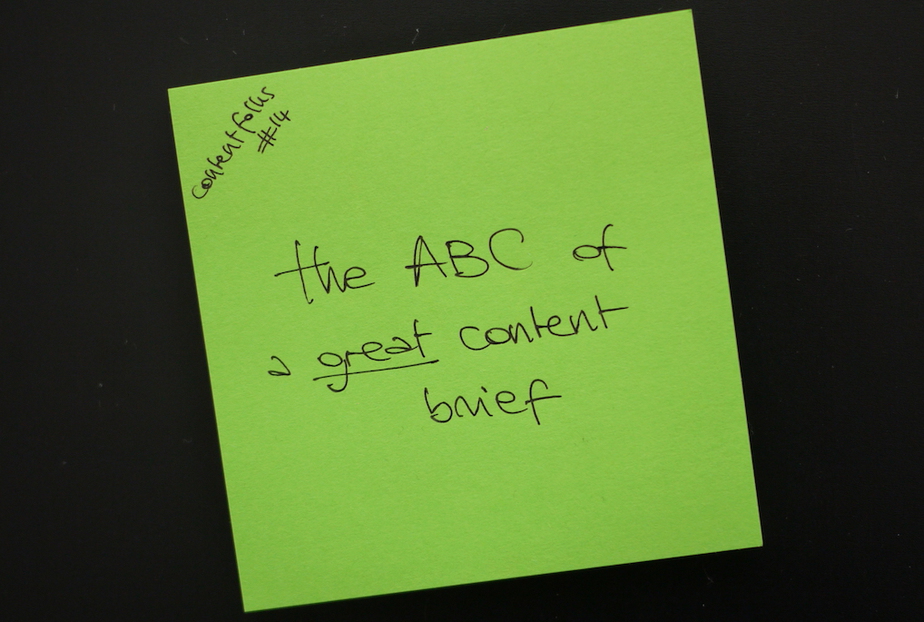
Welcome to contentfolks—a fortnightly newsletter with short lessons & ideas about content that makes a difference, sparks action, and truly serves its audience. Thank you for being here!
Hey 👋
A published blog post is like the tip of an iceberg: under its most visible part sits a huuuuuge amount of stuff that usually goes unseen—and is, therefore, easy to ignore.
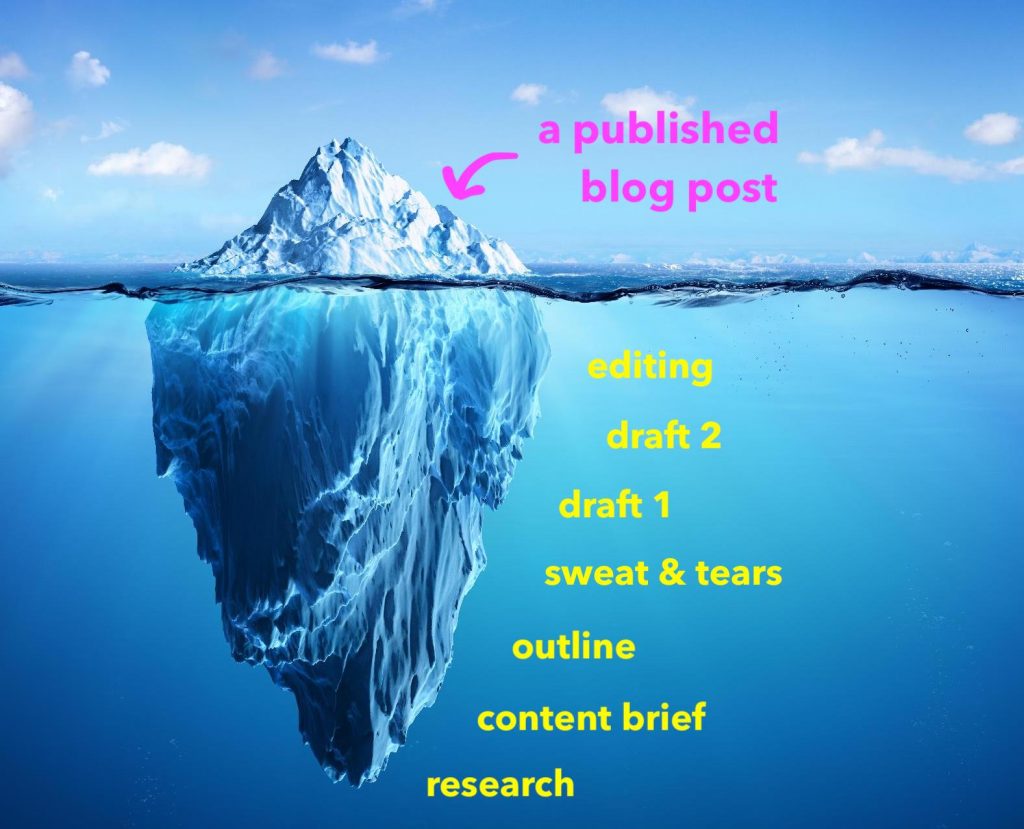
Well then: you are officially invited to join me on a multi-week exploratory mission of a content iceberg 🔎 🗺️
I just started working on an Ahrefs blog post about content calendars, and over the next few issues I’ll use that blog post to break down the invisible process into its main parts and show you what each looks like—starting from research and content brief today, moving to outline next, then to drafting, and finally through a round of edits.
By the time I’m done with this mini-series, the piece should be live and you’ll be able to see it in all its final, iceberg-tipped published glory.
It all starts from a content brief
Once a blog post idea is given the go-ahead, the first invisible step of the process is doing research and putting together a content brief.
A content brief is a short document that content marketers/strategists use to share relevant information and instructions with a writer. It helps clarify a piece’s overall direction and focus, giving the writer enough information to know what to aim for without overwhelming them with detail (it’s called a brief for a reason!).
Content briefs come in many shapes, and might look somewhat like this:
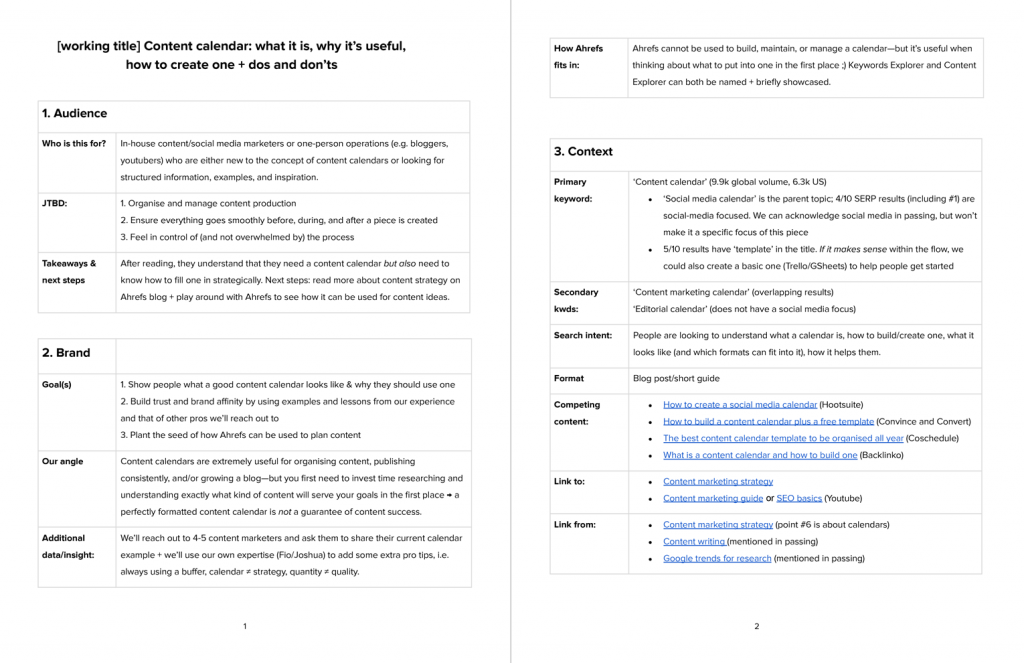
We’ll look at it in more detail below. For now, notice how I organised it in three blocks:
- Audience
- Brand
- Context
…which, very conveniently for me, spells ABC 😉
💡 A practical example 💡
Back to my upcoming Ahrefs blog post about content calendars. Once we agreed there was an opportunity to write about this topic, the first step was for me to do some research, see if the idea was viable, and put together a brief.
This part took a little over 2 hours, during which I researched the main keyword and a few of its variations, reviewed content on the topic and existing Ahrefs pieces aligned with it, and went back and forth to fill in and refine the Audience, Brand, and Context blocks.
I’m both strategising and writing the blog post, so I ended up creating the brief for myself—but the process would be the same if I was doing it for someone else.
1. Audience
I always start a brief from the audience part, because they are the reason we’re writing something in the first place. A great content brief summarises:
- Who the audience is
- Their jobs-to-be-done
- What they should take away from the piece
For my blog post, it looks like this:

To fill this section, I:
- Evaluated Ahrefs’ content marketer persona
- Intersected it with my experience using a content calendar
- Googled ‘content calendar’, saw what was ranking, and skim-read a few pieces to identify the main JTBDs
- Searched for ‘content calendar’ on Youtube and watched a few random clips to build a mental picture of how folks think and talk about the topic
- Consolidated all of this info in as few lines as possible. A writer other than myself would have enough information to use as a jumping-off point for extra research.
🔥 Pro tip: in the jobs-to-be-done (JTBD) section, I name a specific emotion: feeling in control of, and not overwhelmed by, the process. Highlighting both the functional and the emotional components of a job helps a writer understand what tone to keep and which levers to use to create a meaningful connection.
In this case, I’ll likely go for a blend of expert & reassuring.
2. Brand
Each new content piece must fit within the larger narrative of the company behind it. A great content brief clearly states:
- The company’s goal for the piece
- The company’s unique angle and take on the topic
- What additional data or insight could be leveraged
- How the company and its products/services fit into the story
This is what mine looks like:
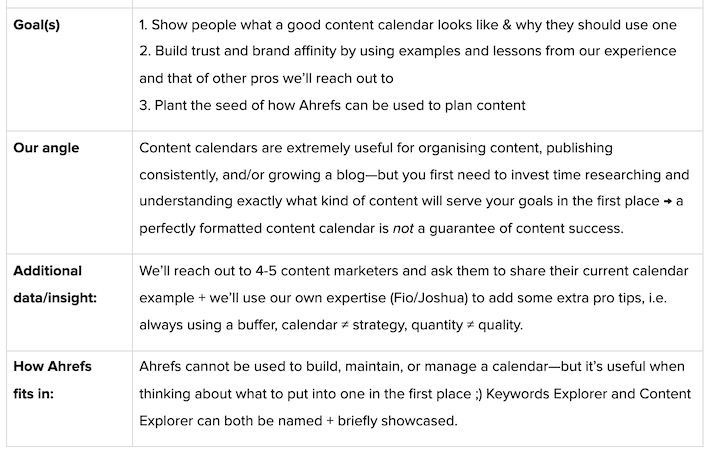
To fill this section, I:
- Spelled out which goals*** this piece should achieve for both audience (#1) and business (#2, #3)
- Workshopped a few angles and picked the one that aligns most with Ahrefs’ strategic approach to content marketing
- Identified a few opportunities to showcase the tool in action (more on how product-led content works here)
- Planned where to add in original information that would make the piece unique
***sidenote: at the draft stage, you can tell a great writer from an okay one by looking at how they act on the ‘goals’ section. The okay writer will tick the box by plonking some product info and calls-to-action somewhere in the draft; the great one will structure the whole piece around the stated goals and make a compelling argument throughout.
3. Context
No content piece exists in a vacuum, and a brief must give a writer some practical contextual information. The info required changes depending on format—for example, what a writer needs to create an ebook is different from what they need to produce a video script.
In my case, this is a keyword-driven blog post, so the data is fairly SEO-focused:
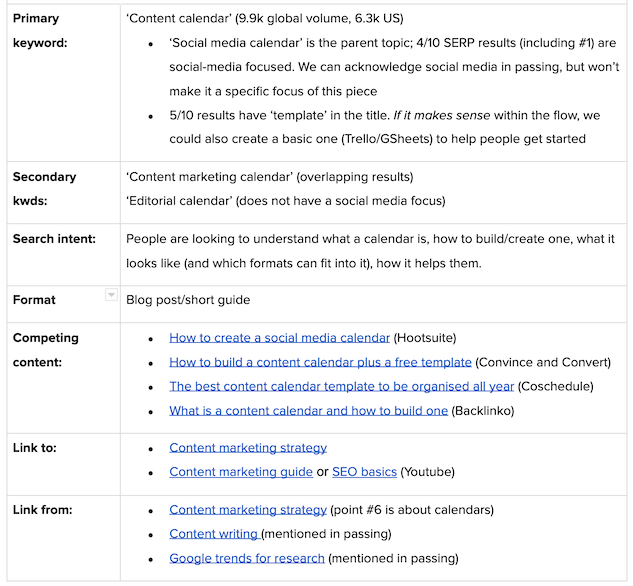
To fill this section, I:
- Used Ahrefs (the tool) to investigate the main keyword and a few variations on it
- Looked at the top-ranking pages to understand search intent
- Looked for existing Ahrefs pieces I could link to/from this blog post
- Reviewed each ranking piece’s structure, main points, angles, and tone…
- …and made a mental note of any arguments they were not making and ideas they were not exploring
🔥 Pro tip: search intent (the reason somebody searched for a specific keyword) is usually one four things: informational, transactional, navigational, or commercial investigation. These labels help with categorisation, but don’t really tell a writer anything substantial—so it’s useful to spell search intent out into an actual sentence.
One thing’s still missing… (or is it)?
My brief is done, but if you’ve ever been on the giving or receiving end of one yourself, you’ll notice something is missing: the recommended word count.
Here’s the truth: as a writer, I always ignore it. As a strategist, I rarely add one.
To me, a piece is done when it’s covered a topic thoroughly and without fluff, in however many words it needed to do so (for example: I have no idea how long any of my newsletters are—I usually stop writing when I’ve done what I intended to do).
Not every strategist agrees with me on this point, though; likewise, some writers prefer anchoring their work to a specific number (e.g., 1800) or ballpark figure (e.g. 1500-2000 words). If you must add a number, you can probably look at the word counts of the top-5 or top-10 ranking pages and average them out.
With the brief done, the first part of the iceberg has been successfully explored ✅
Next time (April 7) we’ll move on to the next part of the process: the outline.
Until then, I made the brief public so you can check it out. You are 110% encouraged to leave comments: I’m creating in public because I’m curious to see how our processes differ. Don’t be shy!
